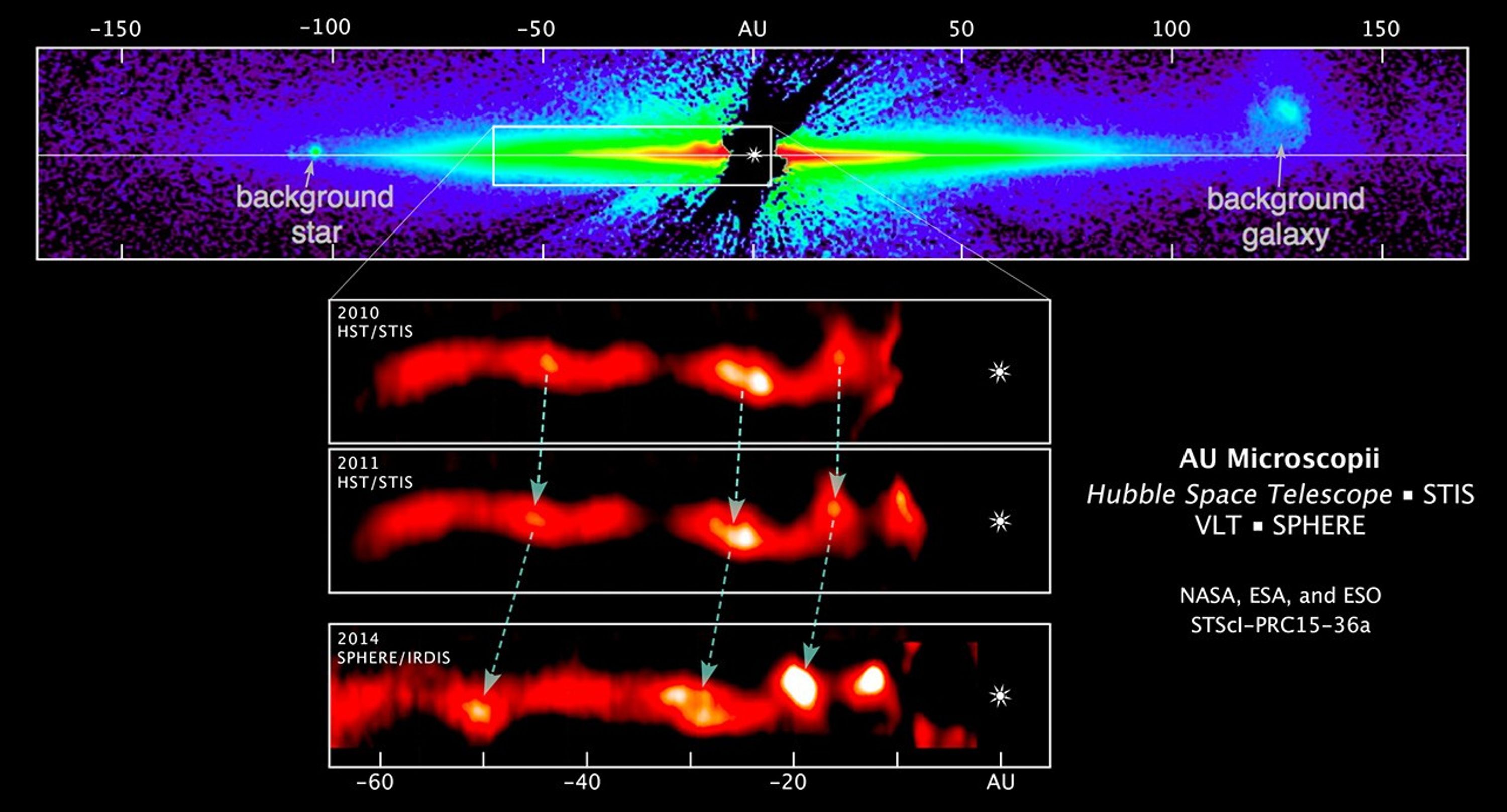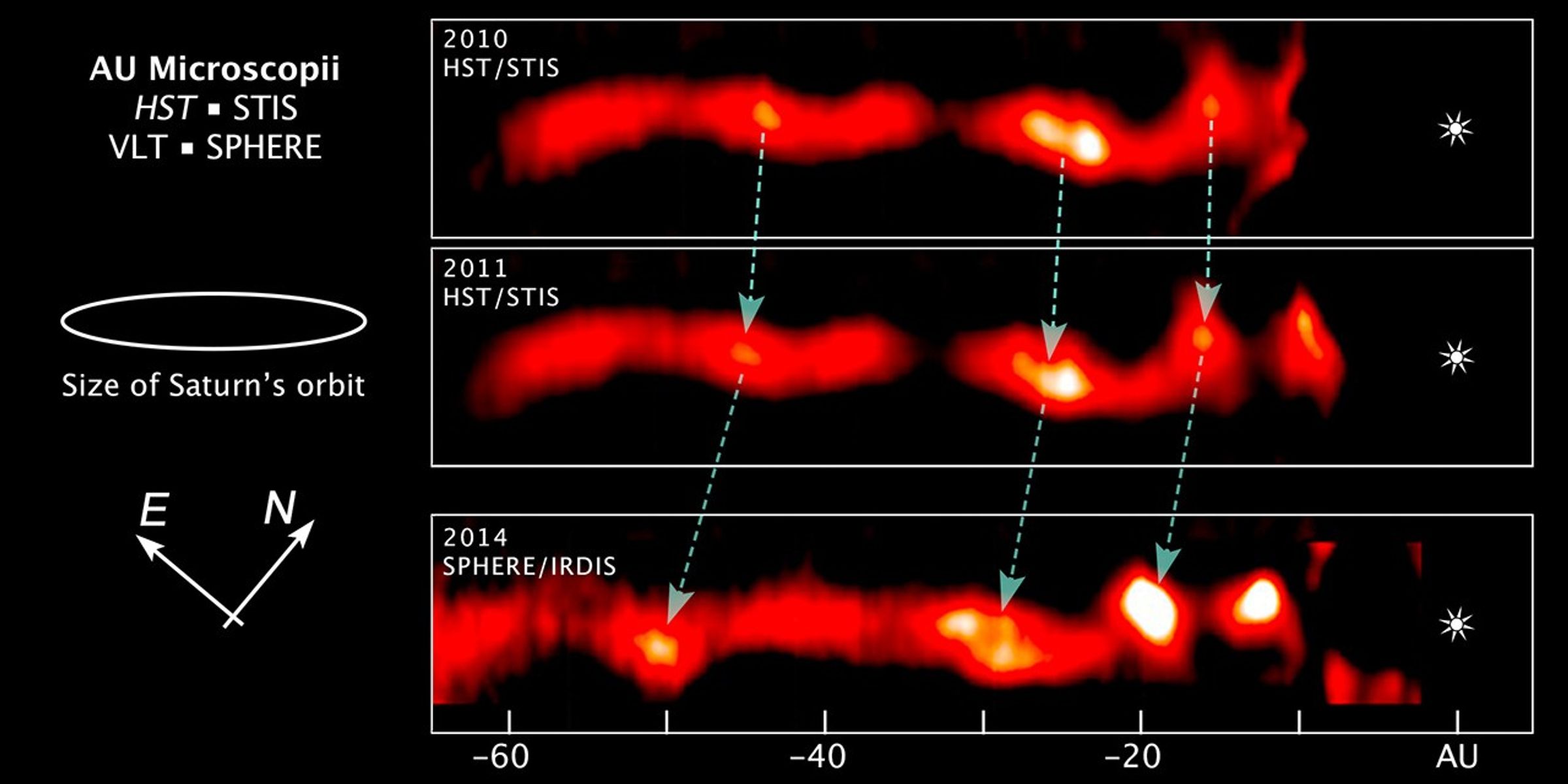1 min read
AU Microscopii Debris Disk

About the Object
- R.A. PositionR.A. PositionRight ascension – analogous to longitude – is one component of an object's position.20h 45m 9.49s
- Dec. PositionDec. PositionDeclination – analogous to latitude – is one component of an object's position.-31° 20' 26.99"
- ConstellationConstellationOne of 88 recognized regions of the celestial sphere in which the object appears.Microscopium
- DistanceDistanceThe physical distance from Earth to the astronomical object. Distances within our solar system are usually measured in Astronomical Units (AU). Distances between stars are usually measured in light-years. Interstellar distances can also be measured in parsecs.32 light-years (9.9 parsecs)
About the Data
- Data DescriptionData DescriptionProposal: A description of the observations, their scientific justification, and the links to the data available in the science archive.
Science Team: The astronomers who planned the observations and analyzed the data. "PI" refers to the Principal Investigator.Hubble data for this release were obtained from HST proposal 12228: PI: G. Schneider and AU Mic data team: C. Stark (NASA/GSFC), J. Debes (STScI), C. Grady (Eureka Scientific), D. Hines (STScI), M. Kuchner (NASA/GSFC), M. Perrin (STScI), M. Silverstone (Eureka Scientific), A. Weinberger (Carnegie Institution of Washington), J. Wisniewski (University of Oklahoma, Norman), P. Hinz (University of Arizona), J. Carson (College of Charleston), T. Henning (Max Planck Institute for Astronomy, Heidelberg), A. Moro-Martin (STScI), M. Tamura (National Astronomical Observatory of Japan), H. Jang-Condell (University of Wyoming, Laramie), B. Woodgate (NASA/GSFC), M. Goto (Max Planck Institute for Astronomy, Heidelberg), and G. Serabyn (JPL). The international team of astronomers in this study consists of: A. Boccaletti (Paris Observatory, CNRS, France), C. Thalmann (ETH Zürich, Switzerland), A.-M. Lagrange (University of Grenoble Alpes, France; CNRS, IPAG, France), M. Janson (Stockholm University; Max Planck Institute for Astronomy), J.-C. Augereau (University of Grenoble Alpes, France; CNRS, IPAG, France), G. Schneider (Steward Observatory, University of Arizona), J. Milli (ESO, Chile; CNRS, IPAG, France), C. Grady (Eureka Scientific), J. Debes (STScI), M. Langlois (CNRS/ENS-L, France), D. Mouillet (University of Grenoble Alpes; CNRS, IPAG, France), T. Henning (Max Planck Institute for Astronomy), C. Dominik (University of Amsterdam), A.-L. Maire (INAF-Observatory of Astronomy, Padova, Italy), J.-L. Beuzit (University of Grenoble Alpes; CNRS, IPAG, France), J. Carson (College of Charleston), K. Dohlen (CNRS, LAM, France), M. Feldt (Max Planck Institute for Astronomy), T. Fusco (ONERA, France; CNRS, LAM, France), C. Ginski (Sterrewacht Leiden, Netherlands), J. Girard (ESO, Chile; CNRS, IPAG, France), D. Hines (STScI), M. Kasper (ESO, Germany; CNRS, IPAG, France), D. Mawet (ESO, Chile), F. Ménard (University of Chile), M. Meyer (ETH Zürich, Switzerland), C. Moutou (CNRS, LAM, France), J. Olofsson (Max Planck Institute for Astronomy), T. Rodigas (Carnegie Institution of Washington), J.-F. Sauvage (ONERA, France; CNRS, LAM, France), J. Schlieder (NASA Ames Research Center; Max Planck Institute for Astronomy), H.M. Schmid (ETH Zürich, Switzerland), M. Turatto (INAF-Observatory of Astronomy, Padova, Italy), S. Udry (Geneva Observatory, Switzerland), F. Vakili (University of Nice-Sophia Antipolis, CNRS, France), A. Vigan (CNRS, LAM, France; ESO, Chile), Z. Wahhaj (ESO, Chile; CNRS, LAM, France) and J. Wisniewski (University of Oklahoma, Norman). - InstrumentInstrumentThe science instrument used to produce the data.Steward Observatory
- Object NameObject NameA name or catalog number that astronomers use to identify an astronomical object.AU Mic, AU Microscopii
- Object DescriptionObject DescriptionThe type of astronomical object.Debris Disk Around Nearby Star
- Release DateOctober 7, 2015
- Science ReleaseMysterious Ripples Found Racing Through Planet-Forming Disk
- Credit
Related Images & Videos
Share
Details
Last Updated
Aug 17, 2025
Contact
Media
Claire Andreoli
NASA’s Goddard Space Flight Center
Greenbelt, Maryland
claire.andreoli@nasa.gov




































